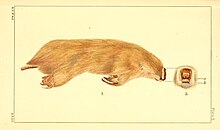Notoryctes typhlops
| Southern marsupial mole | |
|---|---|
 |
|
| Scientific classification | |
| Kingdom: | Animalia |
| Phylum: | Chordata |
| Class: | Mammalia |
| Infraclass: | Marsupialia |
| Order: | Notoryctemorphia |
| Family: | Notoryctidae |
| Genus: | Notoryctes |
| Species: | N. typhlops |
| Binomial name | |
|
Notoryctes typhlops (Stirling, 1889) |
|
 |
|
| Southern marsupial mole range | |
The southern marsupial mole (Notoryctes typhlops) is a mole-like marsupial found in the western central deserts of Australia. It is extremely adapted to a burrowing way of life. It has large, shovel-like forepaws and silky fur, which helps it move easily. also lacks complete eyes as it has little need for them. It feeds on earthworms and larvae.
Although the southern marsupial mole was probably known by aborigines for thousands of years, the first specimen examined by the scientific community was collected in 1888. Stockman W. Coulthard made the discovery on Idracowra Pastoral Lease in the Northern Territory by following some unusual prints that lead him to the animal lying under a tussock. Not knowing what to do with the strange creature, he wrapped it in a kerosene soaked rag, placed it in a revolver cartridge box and forwarded it to E.C. Stirling, the Director of the South Australian Museum. Due to the poor transportation conditions of the time, the specimen reached its destination in a badly decomposed state. Hence, Stirling was unable to find any evidence of the pouch or epipubic bones and decided the creature was not a marsupial.
19th century scientists believed that marsupials and eutherians had evolved from the same primitive ancestor and were looking for a living specimen that would act as the missing link. Because the marsupial mole closely resembled the golden moles of Africa, some scientists concluded that the two were related and that they had found the proof. This is of course not the case, as it became obvious by examining better preserved specimens that had a marsupial pouch.
Although the family Notoryctidae is poorly represented in the fossil record there is evidence of at least one distinct genus Yalkaparidon, in the early Miocene sediments in the Riversleigh deposit in northern Australia.
...
Wikipedia

